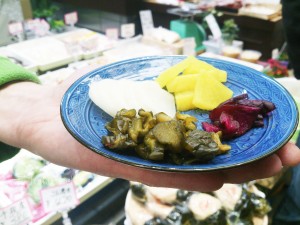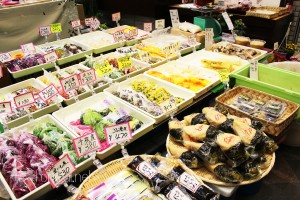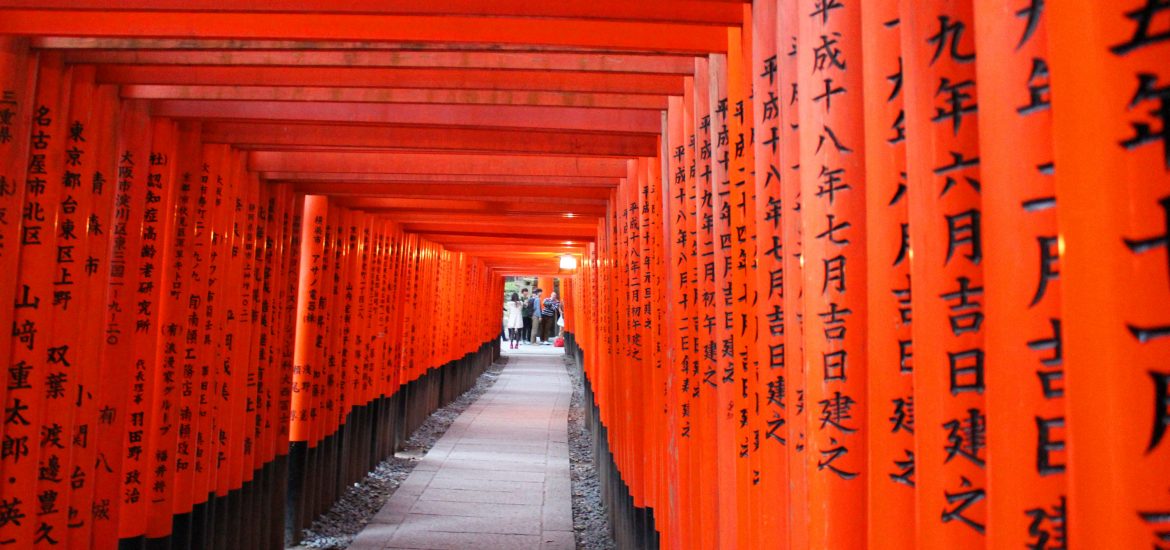Oyakodon. Ramen.
Japanese diner staple food. A rice bowl topped with a chicken-egg-onion scramble, and a bowl full of tasty broth with noodles and toppings.
These were the first things Mr. Forkful and I ate after a late-March 19-hour flight into Narita International and a loong late-night train ride to Kyoto. Not the romanticized idea I had in my head of food in Kyoto, but DANG, did that oyakodon and miso ramen taste good after more than 30+ hours of being awake. We make an oyakodon for dinner every other week these days.
After a ton of sleep, we were ready for Kyoto’s food stories.
PICKLES IN KYOTO
We quickly learned that a meal in Kyoto is not complete without one of the local specialties, tsukemono — pickles! I’m a Puerto Rican American. To me, a pickle is a salty or sweet cucumber. In Kyoto, a pickle can be just about anything.
Kyoto is inland and pickling became the tradition because it just made things last longer. There’s wet pickling but there’s also dry pickling; a technique that requires a giant barrel, a crumbly mixture of salty miso paste, shoyu, and kombu (kelp), and strong arms! The barrels have to be stirred constantly or else the pickled veggies like eggplant, turnips, or beets stick together and mold — and not in a good way. And believe me, there is a good way.


FERMENTATION IN FUSHIMI
A quick ride south of Kyoto on the Kintetsu Line landed us at Momoyamagoryomae Station and in the heart of Fushimi-ku.
Our food tour with JD Kai Tour encompassed the Fushimi Otesuji shotengai (shopping streets), several nearby food stalls, and a sake brewery. The farmer’s market in Fushimi itself is a mini food metropolis within a metropolis. Families have passed these businesses down to their kids for generations. Croquettes, fish cakes, egg sushi stuffed with octopus, seasonal sakura griddle cakes, and more — there seemed to a food stall that perfected each bite in this area.
The katsuobushi (fish fillets smoked over oak and dried so hard they feel fossilized) was shaved into delicate flakes varying in thickness and size at stall by man who only uses the traditional method of a kanna (a wooden mandolin-looking thing). These flakes add the umami (savory) flavor in a lot of Japanese dishes.
We were then treated to obanzai ryori (Kyoto homestyle cooking) by Yoshie Ishiguro in her shop, Shokuiku Kitchen Ishiguro. All those local specialty pickles, boiled veggies, kelp, and fish were served on tiny plates. Another thing I loved about our Japan trip, all the unique plates!
SAKE
Back to mold. Yes, mold is delicious. Wait! Don’t be scared. If you like soy sauce or sake, then you like mold. Soy sauce is made from a fermented soy bean mash, and a main ingredient in sake is koji (mold grown on steamed rice). See, we’ve been enjoying moldy things all along.
After the food tour came to a close in a 100+ year-old tea room, Mr. Forkful and I weren’t ready to say adios and signed up for the sake tour on the spot. A few side streets later landed us underneath a brown sugidama (cedar ball) in front of a non-descript liquor store stocked with local sakes. The cedar ball is a time-honored tradition of advertising sake, and the color (from green/young to brown/aged) indicates the age of the sake being sold or brewed.
Mr. Forkful and I huddled around a barrel with our Australian friends and were served several different sakes that varied from the milling rate of the rice, to distillation, to added liquors. We were all very happy and ready for more sake.

A short walk later, we were standing at the doors of Gennkeikan Okura Sake Brewery and Museum. I looked up and there was a brown cedar ball. YES. We learned about the evolution of sake-making from giant, wooden barrels to stainless steel barrels. We learned about the fineness of the sake being dependent on how high the milling rate of the rice. We learned that those smaller wooden barrels with labels are busted open at weddings and other celebrations just like we open a bottle of champagne. We also had more sake.
Lamentably, it was time for our tour to come to a close. Our final stop was Ginjo Shubo Aburacho, a little sake store back in the Fushimi Otesuji shotengai. Surprise! Not only was there more sake, but there over 80 brands of locally brewed Fushimi sake to taste and buy in this store. Mr. Forkful and I also discovered a new love for nigorizake or unfiltered cloudy sake.
We ended our day at the Fushimi Inari Shrine and its iconic 10,000 torii gates as the sun set over Kyoto.
In short, fermentation makes the world go round in Kyoto.













































